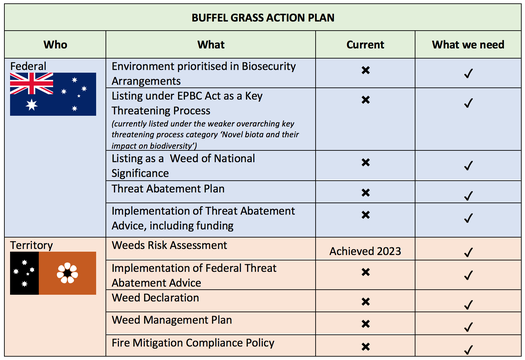
THE ISSUE
The Federal government is failing to fulfil their roles and responsibilities in relation to buffel grass invasion.
BACKGROUND
Buffel grass was introduced to Australia's arid and semi arid regions to provide pasture for stock and to stabilise soils that were eroded as a result of over-grazing.
Buffel grass has spread far beyond planted areas and now dominates many landscapes. It is recognised as one of the greatest threats to arid and semi-arid ecosystems in Australia.
- Buffel grass quickly covers the ground, displacing native grasses and small plants.
- It dominates light and space, reducing opportunities for native vegetation ...
THE ISSUE
The Federal government is failing to fulfil their roles and responsibilities in relation to buffel grass invasion.
BACKGROUND
Buffel grass was introduced to Australia's arid and semi arid regions to provide pasture for stock and to stabilise soils that were eroded as a result of over-grazing.
Buffel grass has spread far beyond planted areas and now dominates many landscapes. It is recognised as one of the greatest threats to arid and semi-arid ecosystems in Australia.
- Buffel grass quickly covers the ground, displacing native grasses and small plants.
- It dominates light and space, reducing opportunities for native vegetation, including trees, to establish.
- It reduces soil nitrogen and exhausts the mineral pool.
- Buffel grass has an extremely high fuel load and rapidly regrows after fire. It causes very hot, widespread, frequent fires.
- Buffel grass in waterholes, rivers and floodplains changes surface water flows and severely damages aquatic ecosystem.
- Buffel grass adversely affects population numbers, habitat quality and geographic distribution of listed threatened species and ecological communities. Because buffel grass destroys habitat it poses a catastrophic threat to native wildlife.
- Studies have ranked buffel grass higher than any other environmental threat in terms of its social and cultural impacts for Aboriginal people.
Buffel grass is already found in every mainland state and the Northern Territory. 70% of the Australian continent is suitable for buffel growth.
We need our representatives in the Federal government to lead the response to this threat at a national level.
WHAT IS NEEDED FROM THE FEDERAL GOVERNMENT
Stronger Protection under Federal laws and regulation
Listing as a stand-alone Key Threatening Process (KTP)
Buffel grass is currently listed under the overarching threatening process ‘novel biota and their impact on biodiversity’ under the Federal Environmental Protection and Biodiversity Conservation Act 1999 (EPBC). This listing is extremely broad and covers a very wide range of established and potential invasive species.
Separate listing gives formal recognition that buffel grass invasion is a key threat to biodiversity at the national level, it raises awareness of how buffel grass threats to biodiversity are operating across Australia and assists with understanding and prioritising research, planning and managing these threats.
Listing as a Weed of National Significance (WoNS)
WoNS is a list of the most problematic plant species in Australia as determined by the federal government. The list is based on invasiveness, impacts, potential for spread, and socioeconomic and environmental values.
WoNS have individual national strategic management plans. These plans define responsibilities and identify strategies and actions to control the weed species. They facilitate coordinated action from all stakeholders at a national level and improve linkages between research and ongoing control (7).
Buffel grass needs to be recognised as a WoNS given the current and potential scale, impact of the threat and complexity of management.
Implementation of Federal Threat Abatement Advice
In 2012 the Federal Threatened Species Scientific Committee published threat abatement advice which aims to provide information and guidance to abate the threat of ecosystem degradation, habitat loss and species decline in arid and semi-arid Australia due to buffel grass invasion.
The Federal government must fulfil its roles and responsibilities and provide coordination, communication, funding and policy development for the actions described in the advice.
REQUEST TO FEDERAL REPRESENTATIVES
1. National leadership on buffel management
2. Listing under the EPBC Act as a stand-alone key threatening process
3. Listing as a ‘Weed of National Significance’
4. Implement Federal Threat Abatement Advice in full
5. Allocate funding at a scale commensurate with the problem
Buffel Grass Invasion - Federal Response
Email Federal Ministers and call on them to respond appropriately to the threat of buffel grass invasion.
Your letter will be sent to:
Prime Minister - Anthony Albanese
Minister for the Environment - Tanya Plibersek
Representative for Lingiari - Marion Scrymgour
Minister for Indigenous Australian - Linda Burney